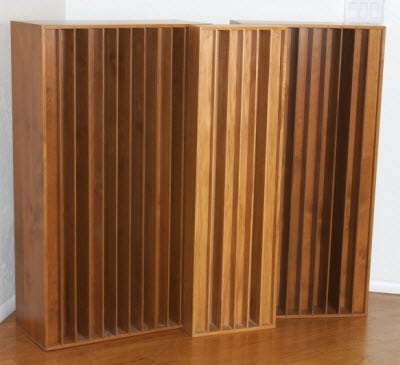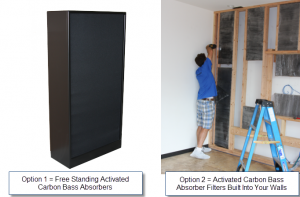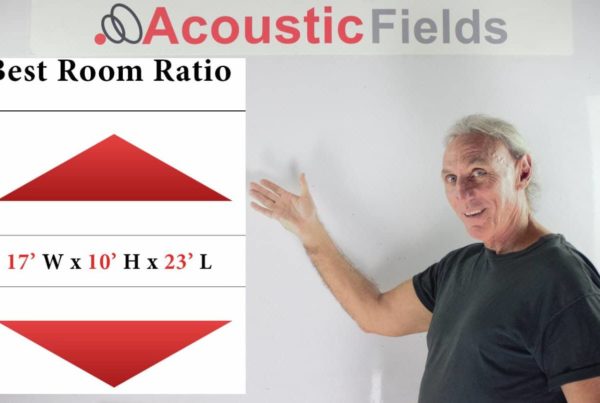In last week’s Google Hangout I was asked the following: “I’ve been reading some guides about acoustic treatment for home studios but I’m a little lost as there’s quite a bit of conflicting info. Where do I need to start? What kind of treatment am I likely to need?”
Okay, so here’s a home studio, we’re going to assume a project studio as remember we have to know room usage as our starting point. What is the usage? So let’s define the usage. The usage, I’m going to assume is a little project studio. I’m going to assume it’s in a bedroom or room that’s not being used.
Matching acoustic treatment for home studios to the room usage is critical
So we’re going to try to make music in a small room. We’re going to try to monitor music during playback in a small room. Okay, now we need to look at pressure levels. What pressure levels are we going to operate at? If it’s a small room they’ll be low. Maybe he’ll be using headphones, maybe not, he probably should use both. So that said then we need to look at the room size and volume, how does the room size and volume compare to the usage, compare to the pressure levels, compare to what’s going to happen in the room?
Are we going to bring in somebody and record acoustic guitar in the room? What are we going to do? So we have to define our usage and our pressure levels first then we look at room size. In answer to your question “how much room treatment am I going to need and of what type?” Unknown, without defining what you’re doing.
This is part of our consultation process. This is part of our process where we iron out all these issues for you ahead of time because you can’t move forward with room acoustics until you match the usage of the room to the room. You just can’t and there’s no general treatment for X, Y or Z without knowing what the room is going to be used for. Because let’s say we have two rooms the same size. One we want to use for vocals and one we want to use for a control room. Let’s say they’re the same size but completely different usages. Well then they will need completely different treatment even though they’re the same size.
So the treatment we would use in the control room will never even occur to be used in a vocal room. Some of the treatment in the vocal room would be used in the control room. So there’s no really general answer and I think this is often the problem for people new to room acoustics. I understand what’s going on out there, I understand why acoustic product manufacturers have tried to make it easy for people to understand but it’s not easy, it’s not simple.
One size does not fit all when it comes to room acoustic treatment for home studios
Getting good quality sound is a combination of all little things done correctly in the right order and sequence. If you miss one thing out of sequence, if you misdiagnosed the treatment the acoustical treatment for reflection management on one wall surface, you ruin the whole room, because all four-wall surfaces have to work together in the lateral domain, the ceiling and the floor have to work together in the vertical domain. So all of these domains and sound fields have to be taken into consideration and matched with usage so that when you start to see one size fits all, turn and run the other way because there could be nothing farther from the truth.
And that’s why people are disappointed in the sound quality of their rooms because I think they’ve been led astray. And I know it’s not easy, I understand that it’s hard. Heck I do it every day and sometimes I still run up against issues that I can’t figure out, well sometimes not many. But because I built so many rooms, most of the issues I see you all out there facing I faced myself and I found ways to treat them but it took time to figure out.
There really is no one size fits all. And if you start to see that in the advertising and the literature of products, be careful because look for products that perform well and look for the ability to apply that technology in the correct way. You can have the greatest product in the world that does all these wonderful things but if you don’t put it in the right place in the room it won’t work.
Now following up with a customer e-mail recently my colleague went and did a little bit of digging and found some manufacturers are giving people product recommendations without knowing basic and yet vital things. There were no questions on what the room for, it was just like, “right buy this, buy this and buy this” and my colleague said to them “you don’t know anything about my room, you did not answer this question but you’re just trying to sell me product”. And I think this must be a problem that other people experiencing. I mean that’s why the customer came to us originally with that issue.
Well this is a perfect example of companies using that one-size-fits-all approach but they’re so drastically different. When I was building and designing conference rooms for voice and then I was helping friends build home theater rooms and some other friends build control rooms and vocal rooms and live rooms, I began to realize very quickly that you have a huge impact on the sound quality of those rooms by the certain treatments that you put in and all the treatments for each room are different.
Acoustic Treatment in a vocal room
There’s a whole litany of things that have to be a achieved in a vocal room. Now they’re less than other rooms but let’s take a vocal room for example. Let’s stick to our two paradigm examples, pressure and reflection management, let’s just keep it simple. Pressure is below a hundred cycles (100 Hz.) and reflection management is everything above a hundred cycles bouncing off the walls. So let’s just focus on those two areas, pressure and reflection to keep it simple.
So in a vocal room, do we have pressure issues? No, we have no low-frequency issues. The human voice doesn’t go below 100, 150, 200 cycles so we don’t have any real pressure issues unless they’re in a bathroom and even then you probably don’t have any. So you have reflection issues, you have reverberation times in a vocal room.
Absorption and diffusion only
So now we have to focus on how do we deal with reverberation and reflection. Absorption and diffusion are the only two technologies we have available. Those two technologies would then be used in the control room where we would also need pressure management (low frequency absorption) because we’re going to have low frequency drivers like drummers in the live room. As a general rule you need a little bit of both in all rooms. That’s probably the easiest in general and safest way I could say it.
Bass Traps Vs Diaphragmatic Absorbers
I’ve just finished a book on waves and ways, which you can get for free here, which offers a good explanation on how waves are everything below 100 hertz. Picture such a low frequency wave as a huge wave coming in with the sea, like a storm wave coming towards your town. Now so you want a sea wall in front of it or just some bits of cardboard? Which do you think is going to defend your town? Because that’s really what we kind of talk about when we talk about the tools available to manage the low. For me Diaphragmatic absorption is the seawall and bass traps filled with building insulation are like the bits of cardboard in this analogy. Which are you’re going to use to stop that wave?
Well that’s what you have to decide. Now that said, stopping the wave completely is not possible. So you have to decide what the biggest sponge I can put between myself and that wave to accomplish two things:
1. Absorb as much of it as I can,
2. let the energy that’s not absorbed pass through it in a way that does not contribute to the problem and does not amplify the issues were trying to resolve.
We want to follow the Hippocratic Oath here, we want to do no harm. So two things, it has to absorb as much energy as it can in the smallest amount of space but you also have to realize that you can’t get it all.
So what are we going to do with the energy that’s left?
We have to release it but we have to release it in a way that ensures it doesn’t increase its ability to cause us more issues. That’s critical so that’s goes with linearity issues in absorption. A lot of companies want to absorb a hundred percent of higher frequencies for reflection management in order to manage it. Well they are, it manages it but you’re trading your energy for management and you can’t do that. Our energy that we put in our rooms to get our sound costs lots of money as amplifiers are expensive, cables are expensive, source material is expensive and recordings are expensive. Every watt of sound energy into your room cost lots of money.
Don’t you want to hear all of it? Don’t you want to hear everything that you’ve paid for? Don’t you want to hear everything that’s in your equipment that you know your equipment can produce? Absolutely, of course you do and absorbing all the energy it produces in order to manage it I think is being lazy on the part of the manufacturer. You don’t have to do that. There’s too much good energy in there you don’t need to “destroy”. I’m going to say destroy in quotes because we do an energy change. Matter is not energy its not created or destroyed but we do change it into other forms so it’s kind of destroyed acoustically. We can’t hear if it’s absorbed, it’s converted to heat we lose it, it’s gone forever.
So I don’t like that management approach with middle and high frequencies. So that said going back to our absorber we’ve got to get that wave before it hits us realizing you’re not going to get all of it. Let the residual wave wash over. And then secondly the absorbing device that we create has to be ready for the next wave cycle to hit. So if it’s a pressure reactive device like our diaphragmatic absorber devices and the pressure wave hits the device and our device starts moving and the absorption process begins, then the rest gets spit out the back and then it’s got to be ready for that next wave which is 11 feet away. See?
So it has three things it has to do and that takes. It took me eight years of R&D to figure out how to do that in a diaphragmatic absorber. That’s why we have the two front walls, that’s why we have the carbon, that’s why we have the cabinets structured the way that we do because it’s all designed to release vibrational energy at the right times to allow all of these three steps I just described to occur and that ain’t easy brother.
In Summary
I hope this discussion on acoustic treatment for home studios. Feel free to contact me directly at: 520 – 392 – 9486 MST or info@acousticfields.com if you have further questions. If you would like to learn more about room acoustics please sign up for my free videos and ebook by joining the mailing list here.
Thanks
Dennis










The discussion on ductwork noise transmission from Acoustic Fields highlights crucial aspects of HVAC system acoustics. The movement of air…
Great build plans. thank you Denis
You must use absorption. Never place a chair against a wall.
A friend and I built several diffusors using these plans and they turned out absolutely beautiful. Very good instructions and…